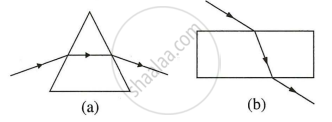Advertisements
Advertisements
प्रश्न
A light ray of yellow colour is incident on an equilateral glass prism at an angel of incidence equal to 48° and suffers minimum deviation by an angle of 36°.
- What will be the angle of emergence?
- If the angle of incidence is changes to (a) 30°, (b) 60°, state whether the angle of deviation will be equal to, less than or more than 36°?
उत्तर
We know that, ∠A= r1 + r2 and i + e = A + δ
- In position of minimum deviation ∠i = ∠e = 48° and for equilateral Δ,
∠A= 60°
∵ i + e = A + 8.
e + e = 60 + 36
2e = 96
e = 48° Angle of Emergence -
We are aware that when the incidence angle increases, the deviation angle first decreases and then reaches the minimum value for a particular incidence angle.
- ∠i = 30°, angle of deviation will be greater than 36°
- at ∠i = 60°, angle of deviation will be greater than 36°
APPEARS IN
संबंधित प्रश्न
Define the term angle of deviation.
Write a relation for the angle of deviation (δ) for a ray of light passing through an equilateral prism in terms of the angle of incidence (i1) angle of emergence (i2) and angle of the prism (A).
Diagrams (a) and (b) in figure below show the refraction of a ray of light of single colour through a prism and a parallel sided glass slab respectively.

- In each diagram, label the incident, refracted, emergent rays and the angle of deviation.
- In what way the direction of emergent ray in the two cases differ with respect to the incident ray? Explain your answer.
How does the angle of deviation depend on the refracting angle of the prism?
An object is viewed through a glass prism with its vertex pointing upwards. Draw a ray diagram to show the formation of its image as seen by the observer on the other side of the object.
A ray of light is normally incident on one face of an equilateral glass prism. Answer the following:
What is the angle of incidence on the first face of the prism?
A ray of light suffers refraction through an equilateral prism. The deviation produced by the prism does not depend on the ______.
Assertion: The light emerges from a parallel-sided glass slab in a direction perpendicular to that in which enters the glass slab.
Reason: The perpendicular distance between the original path of the incident ray and the emergent ray coming out of the glass slab is called lateral displacement of the emergent ray of light.
Explain the phenomenon of dispersion of white light through a glass prism, using suitable ray diagram.
State three factors on which the angle of deviation depends.
